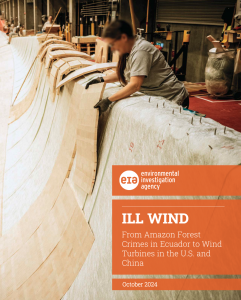The Dirty Supply Chain of Clean Energy: From Amazon Forest Crimes in Ecuador to Wind Turbines in the U.S. and China
— Lisa Handy, Director of Forest Campaigns, EIA US
WASHINGTON, DC, UNITED STATES, October 23, 2024 /EINPresswire.com/ — In order to construct their wind turbine blades, energy giants in the U.S., such as GE Vernova, and leading manufacturers in China, like Goldwind (金风科技) and Mingyang (明阳风电), appear to have relied for years on balsa wood sources that include timber stolen from protected forests and the exploitation of indigenous communities in the Amazon.
During a multi-year investigation, ILL WIND: From Amazon Forest Crimes in Ecuador to Wind Turbines in the U.S. and China, the Environmental Investigation Agency (EIA US) built upon years of reporting to connect the dots between deforestation, human rights violations, and some of the world’s leading wind turbine blade manufacturers. Transitioning to renewables is key to addressing the climate crisis, but energy is only as clean as its supply chain.
Balsa (Ochroma pyramidale) is native to the Americas, and is known for its incredibly light, durable and resistant qualities – which makes it highly desirable for use as a core material in wind turbine blades. The making of a balsa blade core requires the mixing of wood from mature (4-6 year old) trees with that of younger trees in order to achieve the critical blend of average wood density required by blade manufacturers.
Ecuador produces over 90% of the balsa in the world, with annual exports averaging 56,000 tons from 2013 to 2022. EIA investigators found that an industry, which for a decade was able to rely on wood sourced from the dense balsa plantations established in the coastal lowlands of Ecuador, found mature trees difficult to find in plantations during a 2019-2020 surge in demand. In these years, Chinese provinces rushed to meet targets established in response to China’s 2015-2020 five-year national development plan – which made expansion of wind energy capacity a priority.
It was widely reported that to meet the sudden Chinese-driven demand for blade-quality balsa, teams of loggers rushed into national parks and protected indigenous territories in the Ecuadorian Amazon, including the 2.7 million hectare United Nations Educational, Scientific and Cultural Organization (UNESCO) Yasuni Biosphere Reserve. EIA investigators also learned that illegal loggers ventured into neighboring Peruvian forests, smuggled balsa logs to Ecuador, and laundered them as “origin Ecuador.”
EIA’s investigation found that Ecuador’s balsa production continues to depend upon the logging of natural forests, with a blending of plantation vs. natural forest balsa that allegedly varies between 10% and 70%, depending upon the exporter. There are rapidly growing signs that another balsa boom is on the horizon to meet the exponential growth of China’s wind power goals in their current five-year plan, culminating in 2025.
EIA investigators met with the top 13 balsa producers and exporters in Ecuador and learned that leading global blade manufacturers, including TPI Composites and LM Wind Power, have rarely questioned or controlled the origin of the balsa wood they use. Investigators were told that as long as the balsa meets quality and density requirements, origin matters very little. The risk of using contaminated balsa wood extends even further down the supply chain, linking prominent clean energy leaders, such as GE Vernova in the U.S. and Goldwind and Mingyang in China, to illegal logging, violations of Indigenous People’s rights, smuggling, and corruption.
“This necessary energy transition cannot be achieved at the cost of forests and the people who depend upon them,” said Lisa Handy, Director of Forest Campaigns at EIA US. “There is an urgent need for real due diligence, greater transparency and implementation of national traceability systems to improve forest governance and successfully resolve this energy-forest conflict.”
Due to the concentrated nature of the balsa wood supply chain – one major production country with a handful of well-identified exporters – and the fast-growing nature of the species, an opportunity exists for global clean energy leaders like the U.S. and China to work together to prioritize policies and measures that achieve a clean energy transition without destroying protected forests and stealing from indigenous communities. They should support Ecuador in enforcing its laws and implementing an effective transparent timber traceability system. The wind power industry should stop sourcing balsa from the Ecuadorian Amazon until the supply chains are traceable and transparent to ensure that they are not complicit in the destruction of Amazon forests and exploitation of the indigenous communities who live there. EIA urges both China and the U.S. to increase dialogue and mutually beneficial cooperation to achieve a legal, sustainable, fair, traceable, and transparent balsa supply chain.
Denise Stilley
Environmental Investigation Agency
+1 928-225-7315
[email protected]
Visit us on social media:
Facebook
X
LinkedIn
Instagram
YouTube
Other
Legal Disclaimer:
EIN Presswire provides this news content “as is” without warranty of any kind. We do not accept any responsibility or liability
for the accuracy, content, images, videos, licenses, completeness, legality, or reliability of the information contained in this
article. If you have any complaints or copyright issues related to this article, kindly contact the author above.
![]()
Originally published at https://www.einpresswire.com/article/754215026/ill-wind-china-us-leading-wind-turbine-manufacturers-and-u-s-energy-provider-linked-to-illegal-logging-in-the-amazon






